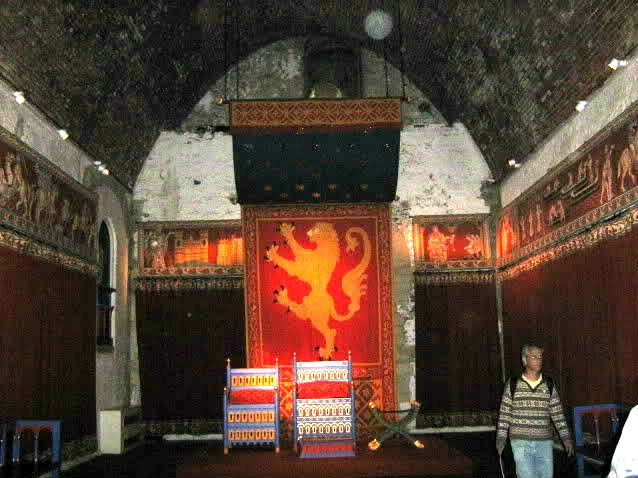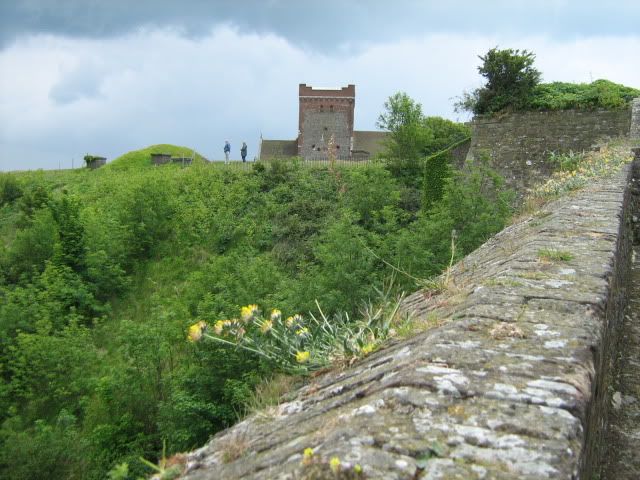This is the latest entry in a series of posts on my vacation trip in May. The prior posts were:
Prologue: To Sleep, Perchance to Dream
Day One: The City of Dreaming Spires
Day Two: Eccentric Ramblings
Day Three: A Funny Thing Happened On the Way to the Palace
Day Four: A Day in Alfred's City
Day Five: Déjà Vu - In a Good Way
Day Six: Artists and Patrons and a Walk by the River
Prologue: To Sleep, Perchance to Dream
Day One: The City of Dreaming Spires
Day Two: Eccentric Ramblings
Day Three: A Funny Thing Happened On the Way to the Palace
Day Four: A Day in Alfred's City
Day Five: Déjà Vu - In a Good Way
Day Six: Artists and Patrons and a Walk by the River
Friday- May 27
Friday we got an early start and took one of the high speed trains to Dover. We really liked the high speed train-- clean, comfortable, convenient and astonishingly quiet. Unlike most people, we weren't just passing through but Dover was our destination. We had all our gear with us, but we didn't let that slow us down—we headed right from the train station to our first planned destination, Dover Castle.
Dover Castle sits on a high promontory overlooking the city. The key word here is 'high'. We had a stiff climb up the hill. My legs very quickly started muttering things like, 'St Paul's yesterday, she's trying to kill us, whine, whine, whine'. I ignored them. Wusses. We arrived in good time at the formidable entrance:
The views were spectacular—here's a view of the moat and outer wall with the breakwater of Dover Harbor in the background.


One of the interesting things is that Dover Castle was used more or less continuously as a fortification for 800 years. It's not just a building, it's a whole complex. The site itself was clearly strategic—it's the crossing-place with the shortest distance to the Continent. Long before Henry the Second there was an Iron Age hill fort there, and there is still a Roman Pharos (lighthouse) in remarkably good condition on the grounds. The present castle was begun in the 1160s, and used right up through World War II. There are sections that were build in the Napoleonic wars, and the cliff underneath the castle itself is riddled with tunnels. The castle chapel, still in use, is Anglo-Saxon.
We started with a tour of some of the WWII era tunnels, that were used as a hospital. We were unfortunately just a few weeks too early to catch their new multimedia exhibit. Some of the parts of the tunnels we would ordinarily have seen were closed while they completed the installation.
Then we went to see the pharos and the chapel. The pharos is astonishing.
Looking up inside you can see where the lamp was lit.
It's not quite so surprising that it's lasted so long when you see how thick the walls are:
(The doorway is a comfortable height for a medium sized person- a taller one would have to duck.)
From there we went up to the castle proper. Interestingly, the castle has been furnished with replica furniture in the styles and colors that would have been used by Henry the Second when he lived there. (Yes, this is the same Henry who got into so much hot water over Thomas Becket.) In addition to the furnishings, there were various audio and holographic exhibits to try and give the visitor a feel for palace life.
Here's the great hall:
Henry's bedchamber:
The view from the top of the tower was pretty fantastic too:
We walked part of the outer walls.
We had a typically excellent lunch (National Trust sites especially tend to have outstanding food, made from fresh local ingredients).
We spent way longer there than we had anticipated, exploring tunnels, viewing some of the channel lookouts used during WWII and viewing exhibits. We were especially taken with the exhibit that talked about Henry the Second's conquests and familial difficulties. He reportedly had more trouble with his four sons than he did with the whole rest of his empire combined.
Finally we decided we ought to get back into Dover and find our hotel. We'd been trekking up and down the hilly Dover Castle site all morning and early afternoon, now we headed back down the steep slope to Dover. (My legs were beyond protest and well into profanity. It availed them naught.)
En route to the hotel, we stopped at the Dover Museum, which had some amazing film footage of the Dunkirk evacuation. This was actually one of the pieces of history that had inspired us to want to come to Dover. For those who are a bit rusty—English and French troops, having resoundingly lost the Battle of Dunkirk, were pinned between the Germans and the water, on the verge of capture. The British mounted a colossal rescue—over 800 boats, and not just military, anything that would float, yachts, ferries, fishing boats and lifeboats. Nowhere is level of desperation better summed up than in James Keelaghan's marvelous song, "The Fires of Calais"
...
On the beach allied confusion, will they stand or are they running
If it's run, where will they go to between the sea and the melee
On the flanks the troops advancing and with heavy guns they're firing
And not a mother's son could save them from the fires of Calais
...
I've fished these channel waters since I was man enough to face them
For the herring and the flounder I have often hauled away
But a catch like this I've never had in forty years of sailing
Saving Tommies as they flounder 'neath the fires of Calais
...
The fishing boats roll out across the dark green channel water
As they gather speed for Flanders they cut their nets away
It's not herring they'll be pulling from the waters on this morning
But they'll reap a bitter harvest from the fires of Calais
The museum also had a fabulous Bronze Age boat, that had been found buried and preserved in water-soaked ground. The amount they learned about boat-building tools and techniques was amazing. And then there was the sheer wonder of being able to stand and look at such an ancient vessel.
We eventually made it to our hotel (which turned out to be right on the beachfront)-
and got checked in and shed our backpacks. We'd been on the lookout for a promising dinner place, but Dover, despite the excellence of its attractions, does not seem to have leveraged them into the kind of touristy place with that has lots of dinner options. However trains were frequent, and since we had already traveled by train that day, any additional travel would be covered by our railpasses (the railpasses gave us unlimited travel for eight non-contiguous days, which we had planned to take full advantage of). So after consulting the internet as to the amenities of nearby towns we could easily reach by rail, we decided to see what we could find in Deal.
As it turned out, Deal did not have a lively restaurant scene—it just had a really competent website designer and marketing consultant. We got off the train—and mind you, this was on the Friday evening of a bank holiday weekend—and the place was completely empty. We walked around in increasing dubiosity through largely deserted streets, looking for any signs of life. We did in the end find a couple of (empty) restaurants and chose an Indian place. The two young waitstaff on duty looked rather surprised to see us, and asked what we wanted. "Dinner," we told them. After a long and utterly non-plussed pause, they leapt to our service with considerable enthusiasm.
We dined in solitary splendor, on quite decent, if not extraordinary food. The staff were extremely attentive. In the whole time we were there, we saw one person come in to pick up takeout, and they had one phone call.
We returned on the train to Dover, and left the station with a handful of other people. Suddenly Dover didn't look so quiet to us. "It's slow," we told each other. "But it's no Deal."
There wasn't any obvious entertainment in Dover that compelled us, but we still had a couple of hours of daylight, so we climbed up to the promontory on the other side of the harbor, opposite Dover Castle. (This is nearly as high as the one Dover Castle sits on. There was faint whimpering from the extremities.) The castle shone gold in the late evening light.
The view up the Dour River valley was pretty, too.
We inspected the Napoleonic fortifications on the summit.
These were largely closed off, and not really a tourist attraction though there was a walking trail that went around and through them. We found a series of interesting plaques that talked about the area. It seems that when the fort was in use, they had direct access to the harbor via a triple spiral staircase that went down through a vertical shaft in the chalk. The triple nature was to provide for segregation of the classes- one stair was reserved for the use of 'officers and their ladies', the middle stair was for 'sergeants and their wives', and the third was for 'soldiers and their women'. We had a good laugh. We soon discovered though, that the spiral stair was the only way down the cliff on this side, so we had to retrace our steps back through the fort and return more or less the way we'd come. We met a local chap walking his dog whom we chatted with briefly. He told us a tall tale about ghostly horses (which we smiled at).
And we made our way back to the hotel, discussing dinner options for the next night. Not Deal, we agreed. Jonathan added, "I'm not sure I could take that kind of excitement two days running."
*
And because I just had too many photos that I wanted to include--check out the Dover photo slideshow:

















Fantastic pictures!!!!!
ReplyDeleteI wanna go! What lovely pictures, Robin. Sigh!
ReplyDeleteWOW. Thank you and a thank you to your weary legs for that tour!
ReplyDelete